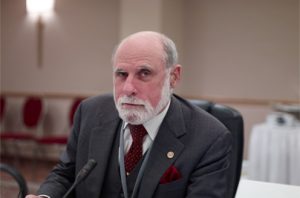Vinton Cerf was a program manager


Date: 01/01/1984
In 1965 Cerf received a bachelor’s degree in mathematics from Stanford University in California. He then worked for IBM as a systems engineer before attending the University of California at Los Angeles (UCLA), where he earned a master’s degree and then a doctorate in computer science in 1970 and 1972, respectively. He then returned to Stanford, where he joined the faculty in computer science and electrical engineering. While at UCLA, Cerf worked under fellow student Stephen Crocker in the laboratory of Leonard Kleinrock on the project to write the communication protocol (Network Control Program [or Protocol]; NCP) for the ARPANET (Advanced Research Projects Agency Network; see DARPA), the first computer network based on packet switching, a heretofore untested technology. (In contrast to ordinary telephone communications, in which a specific circuit must be dedicated to the transmission, packet switching splits a message into “packets” that travel independently over many different circuits.) UCLA was among the four original ARPANET nodes. Cerf also worked on the software that measured and tested the performance of the ARPANET. While working on the protocol, Cerf met Kahn, an electrical engineer who was then a senior scientist at Bolt Beranek & Newman. Cerf’s professional relationship with Kahn was among the most important of his career.
In 1972 Kahn moved to DARPA as a program manager in the Information Processing Techniques Office (IPTO), where he began to envision a network of packet-switching networks—essentially, what would become the Internet. In 1973 Kahn approached Cerf, then a professor at Stanford, to assist him in designing this new network. Cerf and Kahn soon worked out a preliminary version of what they called the ARPA Internet, the details of which they published as a joint paper in 1974. Cerf joined Kahn at IPTO in 1976 to manage the office’s networking projects. Together, with many contributing colleagues sponsored by DARPA, they produced TCP/IP (Transmission Control Protocol/Internet Protocol), an electronic transmission protocol that separated packet error checking (TCP) from issues related to domains and destinations (IP).
Cerf’s work on making the Internet a publicly accessible medium continued after he left DARPA in 1982 to become a vice president at MCI Communications Corporation (WorldCom, Inc., from 1998 to 2003). While at MCI he led the effort to develop and deploy MCI Mail, the first commercial e-mail service that was connected to the Internet. In 1986 Cerf became a vice president at the Corporation for National Research Initiatives, a not-for-profit corporation located in Reston, Virginia, that Kahn, as president, had formed to develop network-based information technologies for the public good. Cerf also served as founding president of the Internet Society from 1992 to 1995. In 1994 Cerf returned to MCI as a senior vice president, and from 2000 to 2007 he served as chairman of the Internet Corporation for Assigned Names and Numbers (ICANN), the group that oversees the Internet’s growth and expansion. In 2005 he left MCI to become vice president and “chief Internet evangelist” at the search engine company Google Inc.
In addition to his work on the Internet, Cerf served on many government panels related to cybersecurity and the national information infrastructure. A fan of science fiction, he was a technical consultant to one of author Gene Roddenberry’s posthumous television projects, Earth: Final Conflict. Among his many honours were the U.S. National Academy of Engineering’s Charles Stark Draper Prize (2001), the Prince of Asturias Award for Technical and Scientific Research (2002), the Presidential Medal of Freedom (2005), the Queen Elizabeth Prize for Engineering (2013), and the French Legion of Honour (2014).